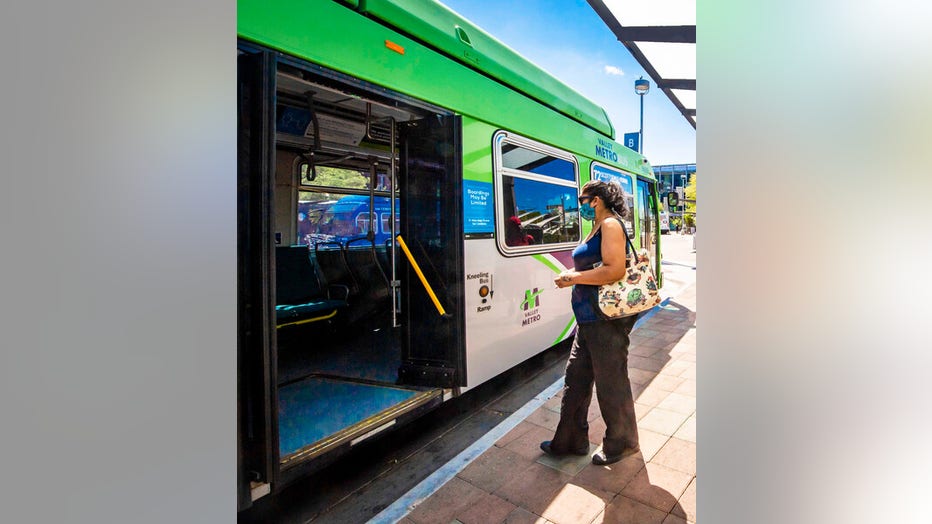Valley Metro to require all riders to wear face masks beginning July 1
PHOENIX - Valley Metro says it will require all riders to wear face coverings on all public transit services beginning July 1.
The new mandate applies to buses, light rails, paratransit, Dial-a-Ride, and vanpools. Masks must also be worn at Valley Metro stops, stations, and transit centers.
Valley Metro says it will distribute masks to riders.

(Valley Metro)
The new mask mandate was made by the board of directors during their June 18 meeting.
The exceptions to the new mandate are children under the age of 2 and those with medical conditions preventing them from wearing masks.
Riders who are not wearing a mask will not be allowed to board or ride.
Governor Doug Ducey announced on June 17 that Arizona mayors are free to make wearing face masks mandatory to slow the spread of coronavirus.
Related
LIST: Arizona cities with face mask requirements
Coronavirus cases continue to skyrocket in Arizona and now, several cities are looking at possible mask mandates.
In order to protect yourself from a possible infection, the CDC recommends:
- Avoid close contact with people who are sick.
- Avoid touching your eyes, nose, and mouth.
- Stay home when you are sick.
- Cover your cough or sneeze with a tissue, then throw the tissue in the trash.
- Clean and disinfect frequently touched objects and surfaces using a regular household cleaning spray or wipe.
- Wash your hands often with soap and water for at least 20 seconds, especially after going to the bathroom; before eating; and after blowing your nose, coughing, or sneezing.
MAP: Worldwide interactive Coronavirus case data
MAP: Arizona Coronavirus cases by zip code
FULL COVERAGE: fox10phoenix.com/coronavirus
Coronavirus (COVID-19)
How it spreads, symptoms, prevention, treatment, FAQ
https://www.cdc.gov/coronavirus
Arizona COVID-19 Response
Public resources, FAQ, webinars
https://www.azdhs.gov/coronavirus
On CoronavirusNOW.com, you'll find extensive coverage about COVID-19, including breaking news from around the country, exclusive interviews with health officials, and informative content from a variety of public health resources.
RELATED:
- How coronavirus differs from flu: Symptoms to watch for
- Is it the flu, a cold or COVID-19? Different viruses present similar symptoms
- Does wearing a face mask protect you from coronavirus and other infectious diseases?
Symptoms for coronavirus COVID-19 include fever, coughing, and shortness of breath. These, of course, are similar to the common cold and flu.
Expect a common cold to start out with a sore or scratchy throat, cough, runny and/or stuffy nose. Flu symptoms are more intense and usually come on suddenly, and can include a high fever.
Symptoms of COVID-19 may appear more slowly. They usually include fever, a dry cough and noticeable shortness of breath, according to the World Health Organization. A minority of cases develop pneumonia, and the disease is especially worrisome for the elderly and those with other medical problems such as high blood pressure, obesity, diabetes or heart conditions.
RELATED: Is it the flu, a cold or COVID-19? Different viruses present similar symptoms
Right now there's one big difference between flu and coronavirus: A vaccine exists to help prevent the flu and it's not too late to get it. It won't protect you from catching the coronavirus, but may put you in a better position to fight it.
To protect yourself, wash your hands well and often, keep them away from your face, and avoid crowds and standing close to people.
And if you do find yourself showing any of these flu or coronavirus symptoms - don't go straight to your doctor's office. That just risks making more people sick, officials urge. Call ahead, and ask if you need to be seen and where.

Wearing a surgical face mask probably won't keep you from getting sick, experts say
The surgical masks that most people buy in response to epidemic outbreaks are not designed to seal around the mouth and nose, which means airborne germs can still come in through the sides and top.



